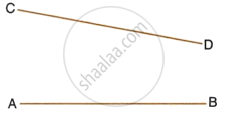Advertisements
Advertisements
Question
Construct a right angled triangle PQR, in which ∠Q = 90°, hypotenuse PR = 8 cm and QR = 4.5 cm. Draw bisector of angle PQR and let it meets PR at point T. Prove that T is equidistant from PQ and QR.
Solution

Steps of Construction:
- Draw a line segment QR = 4.5 cm
- At Q, draw a ray QX making an angle of 90°
- With centre R and radius 8 cm, draw an arc which intersects QX at P.
- Join RP. ΔPQR is the required triangle.
- Draw the bisector of ∠PQR that meets PR in T.
- From T, draw perpendicular PL and PM respectively on PQ and QR.
Proof: In ΔLTQ and ΔMTQ
∠TLQ = ∠TMQ ...(Each = 90°)
∠LQT = ∠TQM ...(QT is angle bisector)
QT = QT ...(Common)
∴ By Angle – Angle – side criterion of congruence,
∴ ΔLTQ ≅ ΔMTQ ...(AAS postulate)
The corresponding parts of the congruent triangles are congruent
∴ TL = TM ...(C.P.C.T.)
Hence, T is equidistant from PQ and QR.
APPEARS IN
RELATED QUESTIONS
The bisectors of ∠B and ∠C of a quadrilateral ABCD intersect each other at point P. Show that P is equidistant from the opposite sides AB and CD.
Draw an angle ABC = 75°. Draw the locus of all the points equidistant from AB and BC.
In the figure given below, find a point P on CD equidistant from points A and B.

Describe the locus of points at a distance 2 cm from a fixed line.
Describe the locus of a runner, running around a circular track and always keeping a distance of 1.5 m from the inner edge.
Describe the locus of points at distances greater than 4 cm from a given point.
Sketch and describe the locus of the vertices of all triangles with a given base and a given altitude.
In Δ ABC, the perpendicular bisector of AB and AC meet at 0. Prove that O is equidistant from the three vertices. Also, prove that if M is the mid-point of BC then OM meets BC at right angles.
Prove that the common chord of two intersecting circles is bisected at right angles by the line of centres.
ΔPBC, ΔQBC and ΔRBC are three isosceles triangles on the same base BC. Show that P, Q and R are collinear.
